Child Obesity Analysis in Year 6: New Cross Ward, Lewisham
VerifiedAdded on 2023/01/17
|15
|2028
|38
Report
AI Summary
This report analyzes the issue of child obesity in the New Cross ward of the London Borough of Lewisham. The report begins with an introduction, outlining the aim and objectives of the study, which is to analyze obesity in children aged 10-11 in Year 6. It then provides a rationale for the study, highlighting the increasing prevalence of childhood obesity and the importance of early intervention. A profile of the local area is presented, followed by a literature review that defines obesity, explores its causes, and examines the issue in the context of the study area. The methodology section details the research approach, including the types of research (qualitative), data collection methods, sampling techniques, and data analysis procedures, including a questionnaire and interpretation of the findings. The report concludes with findings, recommendations and references.
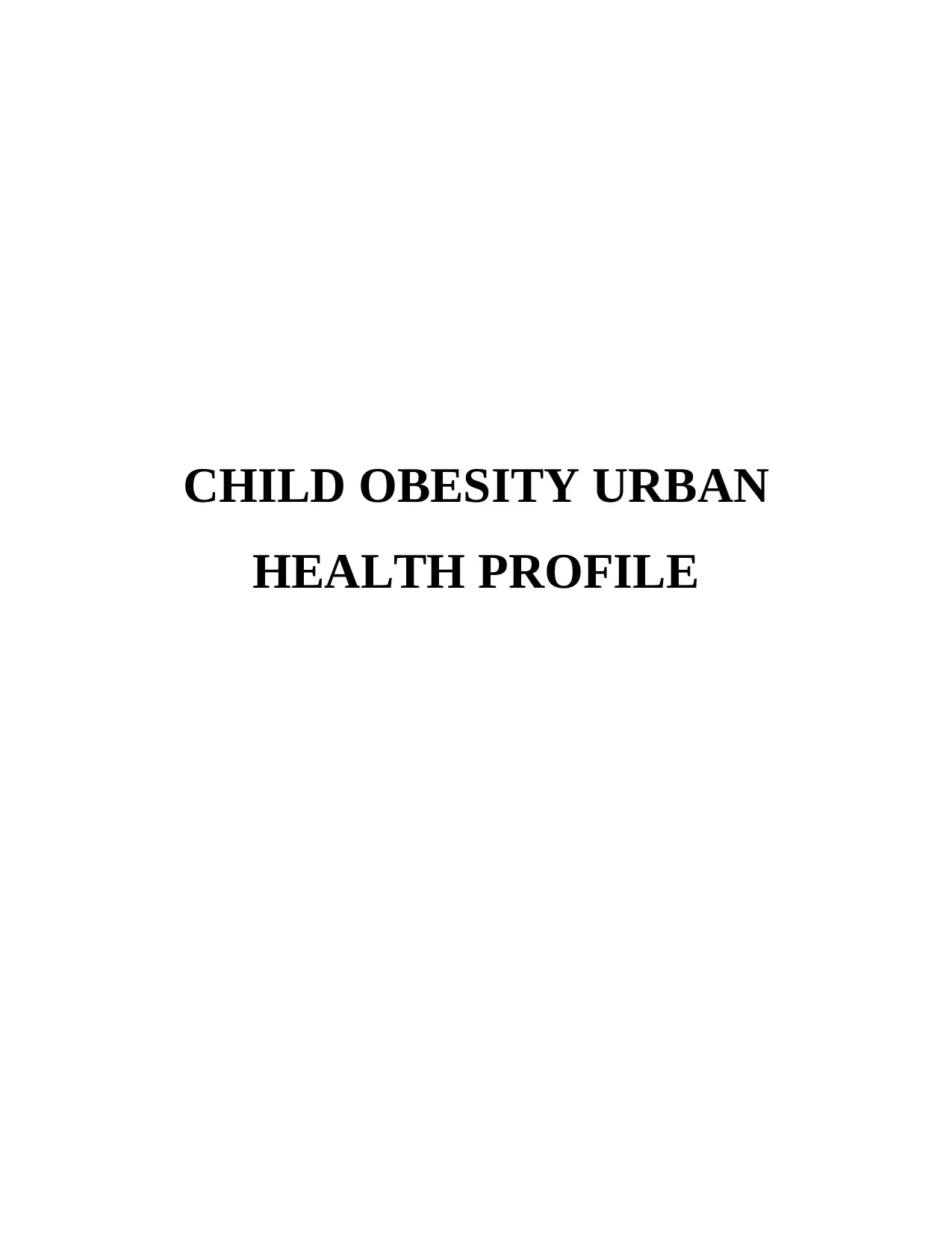
CHILD OBESITY URBAN
HEALTH PROFILE
HEALTH PROFILE
Paraphrase This Document
Need a fresh take? Get an instant paraphrase of this document with our AI Paraphraser
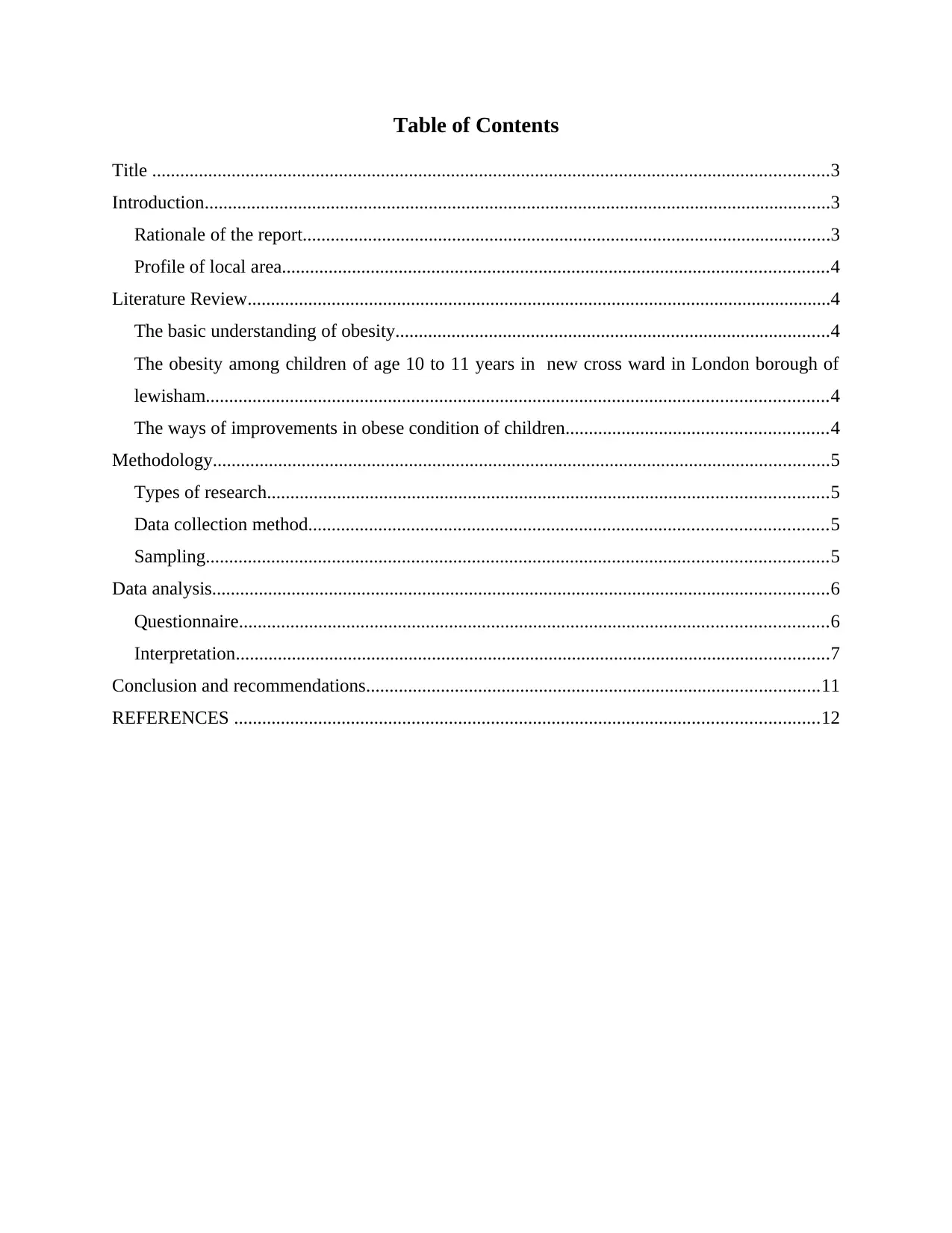
Table of Contents
Title .................................................................................................................................................3
Introduction......................................................................................................................................3
Rationale of the report.................................................................................................................3
Profile of local area.....................................................................................................................4
Literature Review.............................................................................................................................4
The basic understanding of obesity.............................................................................................4
The obesity among children of age 10 to 11 years in new cross ward in London borough of
lewisham.....................................................................................................................................4
The ways of improvements in obese condition of children........................................................4
Methodology....................................................................................................................................5
Types of research........................................................................................................................5
Data collection method...............................................................................................................5
Sampling.....................................................................................................................................5
Data analysis....................................................................................................................................6
Questionnaire..............................................................................................................................6
Interpretation...............................................................................................................................7
Conclusion and recommendations.................................................................................................11
REFERENCES .............................................................................................................................12
Title .................................................................................................................................................3
Introduction......................................................................................................................................3
Rationale of the report.................................................................................................................3
Profile of local area.....................................................................................................................4
Literature Review.............................................................................................................................4
The basic understanding of obesity.............................................................................................4
The obesity among children of age 10 to 11 years in new cross ward in London borough of
lewisham.....................................................................................................................................4
The ways of improvements in obese condition of children........................................................4
Methodology....................................................................................................................................5
Types of research........................................................................................................................5
Data collection method...............................................................................................................5
Sampling.....................................................................................................................................5
Data analysis....................................................................................................................................6
Questionnaire..............................................................................................................................6
Interpretation...............................................................................................................................7
Conclusion and recommendations.................................................................................................11
REFERENCES .............................................................................................................................12
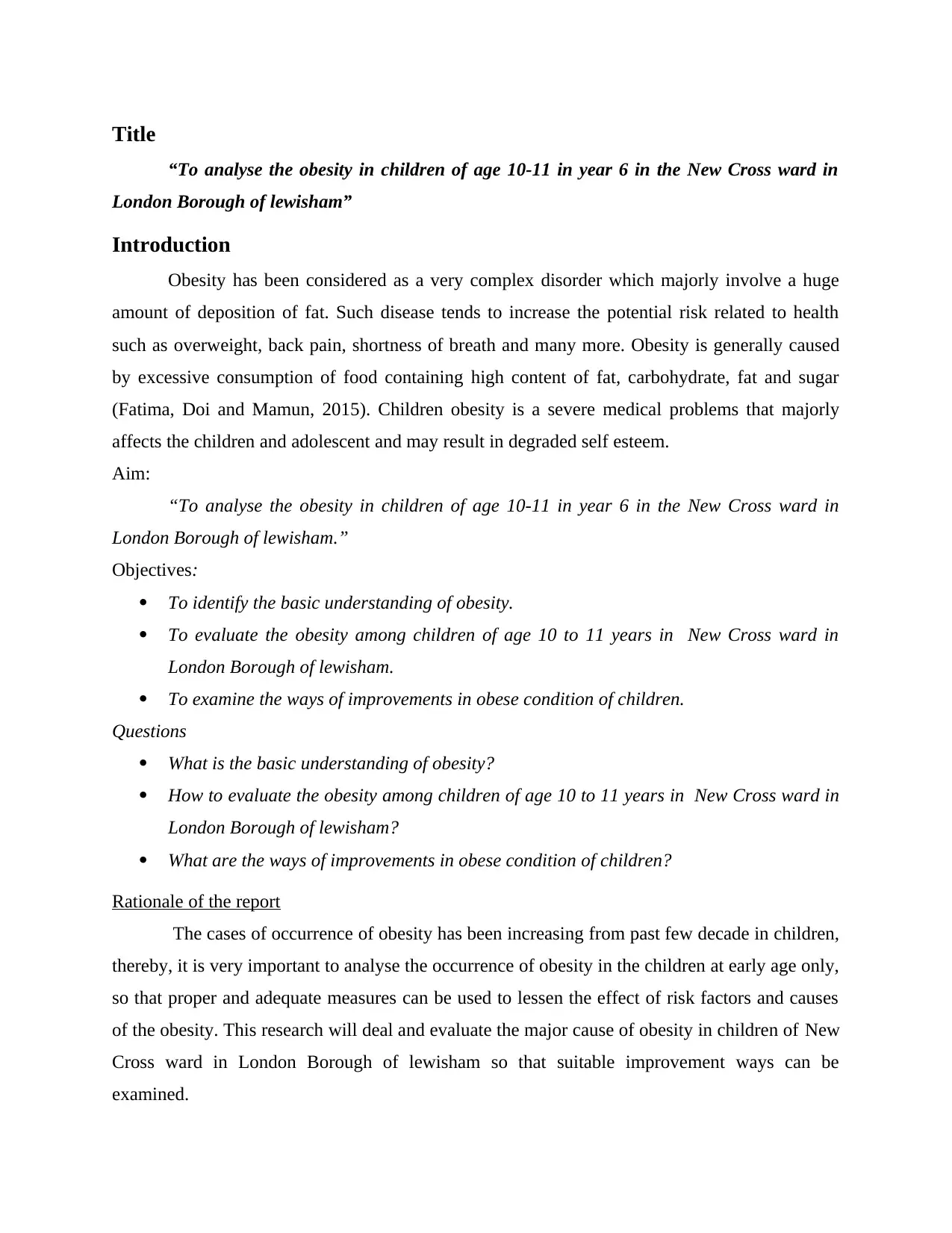
Title
“To analyse the obesity in children of age 10-11 in year 6 in the New Cross ward in
London Borough of lewisham”
Introduction
Obesity has been considered as a very complex disorder which majorly involve a huge
amount of deposition of fat. Such disease tends to increase the potential risk related to health
such as overweight, back pain, shortness of breath and many more. Obesity is generally caused
by excessive consumption of food containing high content of fat, carbohydrate, fat and sugar
(Fatima, Doi and Mamun, 2015). Children obesity is a severe medical problems that majorly
affects the children and adolescent and may result in degraded self esteem.
Aim:
“To analyse the obesity in children of age 10-11 in year 6 in the New Cross ward in
London Borough of lewisham.”
Objectives:
To identify the basic understanding of obesity.
To evaluate the obesity among children of age 10 to 11 years in New Cross ward in
London Borough of lewisham.
To examine the ways of improvements in obese condition of children.
Questions
What is the basic understanding of obesity?
How to evaluate the obesity among children of age 10 to 11 years in New Cross ward in
London Borough of lewisham?
What are the ways of improvements in obese condition of children?
Rationale of the report
The cases of occurrence of obesity has been increasing from past few decade in children,
thereby, it is very important to analyse the occurrence of obesity in the children at early age only,
so that proper and adequate measures can be used to lessen the effect of risk factors and causes
of the obesity. This research will deal and evaluate the major cause of obesity in children of New
Cross ward in London Borough of lewisham so that suitable improvement ways can be
examined.
“To analyse the obesity in children of age 10-11 in year 6 in the New Cross ward in
London Borough of lewisham”
Introduction
Obesity has been considered as a very complex disorder which majorly involve a huge
amount of deposition of fat. Such disease tends to increase the potential risk related to health
such as overweight, back pain, shortness of breath and many more. Obesity is generally caused
by excessive consumption of food containing high content of fat, carbohydrate, fat and sugar
(Fatima, Doi and Mamun, 2015). Children obesity is a severe medical problems that majorly
affects the children and adolescent and may result in degraded self esteem.
Aim:
“To analyse the obesity in children of age 10-11 in year 6 in the New Cross ward in
London Borough of lewisham.”
Objectives:
To identify the basic understanding of obesity.
To evaluate the obesity among children of age 10 to 11 years in New Cross ward in
London Borough of lewisham.
To examine the ways of improvements in obese condition of children.
Questions
What is the basic understanding of obesity?
How to evaluate the obesity among children of age 10 to 11 years in New Cross ward in
London Borough of lewisham?
What are the ways of improvements in obese condition of children?
Rationale of the report
The cases of occurrence of obesity has been increasing from past few decade in children,
thereby, it is very important to analyse the occurrence of obesity in the children at early age only,
so that proper and adequate measures can be used to lessen the effect of risk factors and causes
of the obesity. This research will deal and evaluate the major cause of obesity in children of New
Cross ward in London Borough of lewisham so that suitable improvement ways can be
examined.
⊘ This is a preview!⊘
Do you want full access?
Subscribe today to unlock all pages.

Trusted by 1+ million students worldwide
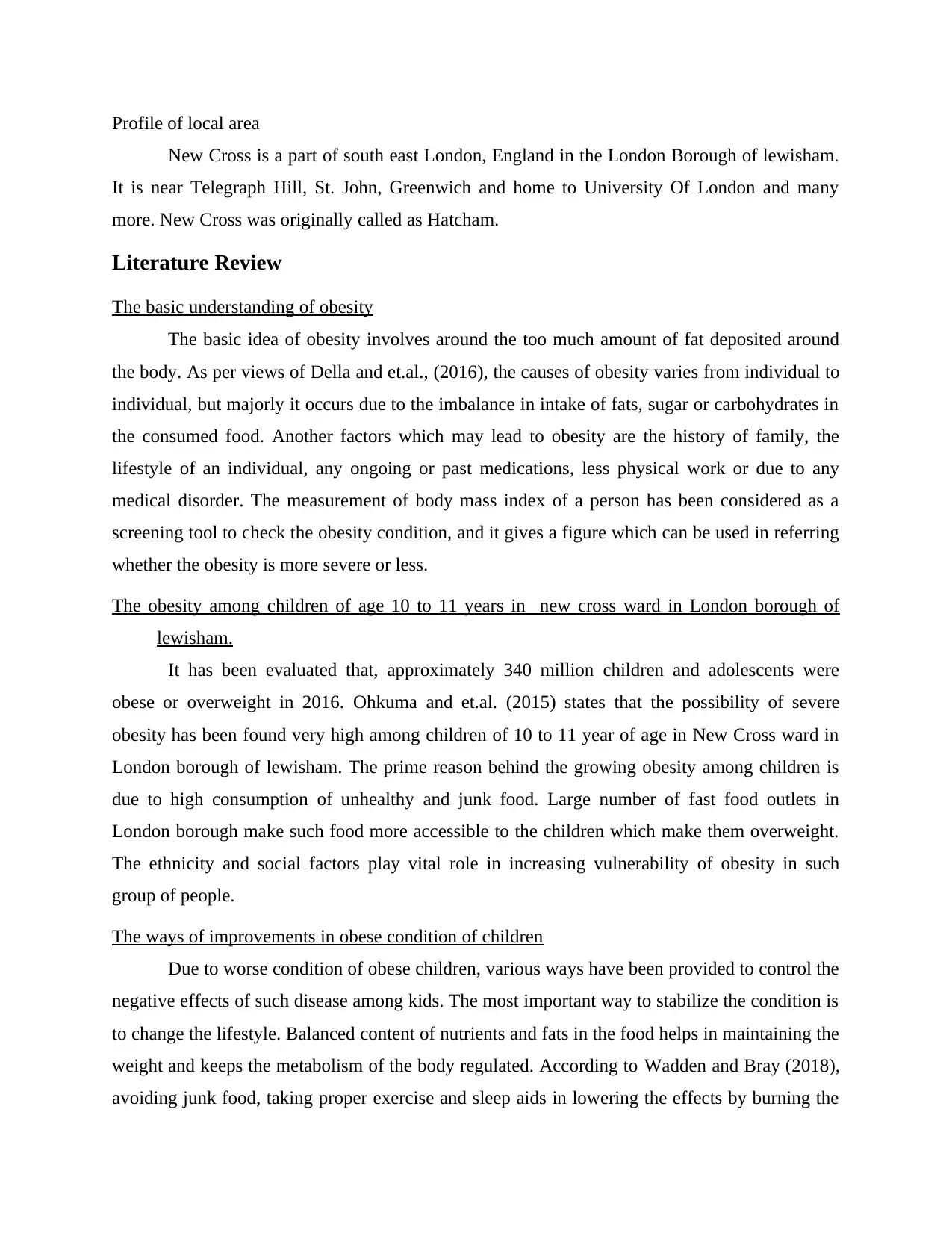
Profile of local area
New Cross is a part of south east London, England in the London Borough of lewisham.
It is near Telegraph Hill, St. John, Greenwich and home to University Of London and many
more. New Cross was originally called as Hatcham.
Literature Review
The basic understanding of obesity
The basic idea of obesity involves around the too much amount of fat deposited around
the body. As per views of Della and et.al., (2016), the causes of obesity varies from individual to
individual, but majorly it occurs due to the imbalance in intake of fats, sugar or carbohydrates in
the consumed food. Another factors which may lead to obesity are the history of family, the
lifestyle of an individual, any ongoing or past medications, less physical work or due to any
medical disorder. The measurement of body mass index of a person has been considered as a
screening tool to check the obesity condition, and it gives a figure which can be used in referring
whether the obesity is more severe or less.
The obesity among children of age 10 to 11 years in new cross ward in London borough of
lewisham.
It has been evaluated that, approximately 340 million children and adolescents were
obese or overweight in 2016. Ohkuma and et.al. (2015) states that the possibility of severe
obesity has been found very high among children of 10 to 11 year of age in New Cross ward in
London borough of lewisham. The prime reason behind the growing obesity among children is
due to high consumption of unhealthy and junk food. Large number of fast food outlets in
London borough make such food more accessible to the children which make them overweight.
The ethnicity and social factors play vital role in increasing vulnerability of obesity in such
group of people.
The ways of improvements in obese condition of children
Due to worse condition of obese children, various ways have been provided to control the
negative effects of such disease among kids. The most important way to stabilize the condition is
to change the lifestyle. Balanced content of nutrients and fats in the food helps in maintaining the
weight and keeps the metabolism of the body regulated. According to Wadden and Bray (2018),
avoiding junk food, taking proper exercise and sleep aids in lowering the effects by burning the
New Cross is a part of south east London, England in the London Borough of lewisham.
It is near Telegraph Hill, St. John, Greenwich and home to University Of London and many
more. New Cross was originally called as Hatcham.
Literature Review
The basic understanding of obesity
The basic idea of obesity involves around the too much amount of fat deposited around
the body. As per views of Della and et.al., (2016), the causes of obesity varies from individual to
individual, but majorly it occurs due to the imbalance in intake of fats, sugar or carbohydrates in
the consumed food. Another factors which may lead to obesity are the history of family, the
lifestyle of an individual, any ongoing or past medications, less physical work or due to any
medical disorder. The measurement of body mass index of a person has been considered as a
screening tool to check the obesity condition, and it gives a figure which can be used in referring
whether the obesity is more severe or less.
The obesity among children of age 10 to 11 years in new cross ward in London borough of
lewisham.
It has been evaluated that, approximately 340 million children and adolescents were
obese or overweight in 2016. Ohkuma and et.al. (2015) states that the possibility of severe
obesity has been found very high among children of 10 to 11 year of age in New Cross ward in
London borough of lewisham. The prime reason behind the growing obesity among children is
due to high consumption of unhealthy and junk food. Large number of fast food outlets in
London borough make such food more accessible to the children which make them overweight.
The ethnicity and social factors play vital role in increasing vulnerability of obesity in such
group of people.
The ways of improvements in obese condition of children
Due to worse condition of obese children, various ways have been provided to control the
negative effects of such disease among kids. The most important way to stabilize the condition is
to change the lifestyle. Balanced content of nutrients and fats in the food helps in maintaining the
weight and keeps the metabolism of the body regulated. According to Wadden and Bray (2018),
avoiding junk food, taking proper exercise and sleep aids in lowering the effects by burning the
Paraphrase This Document
Need a fresh take? Get an instant paraphrase of this document with our AI Paraphraser
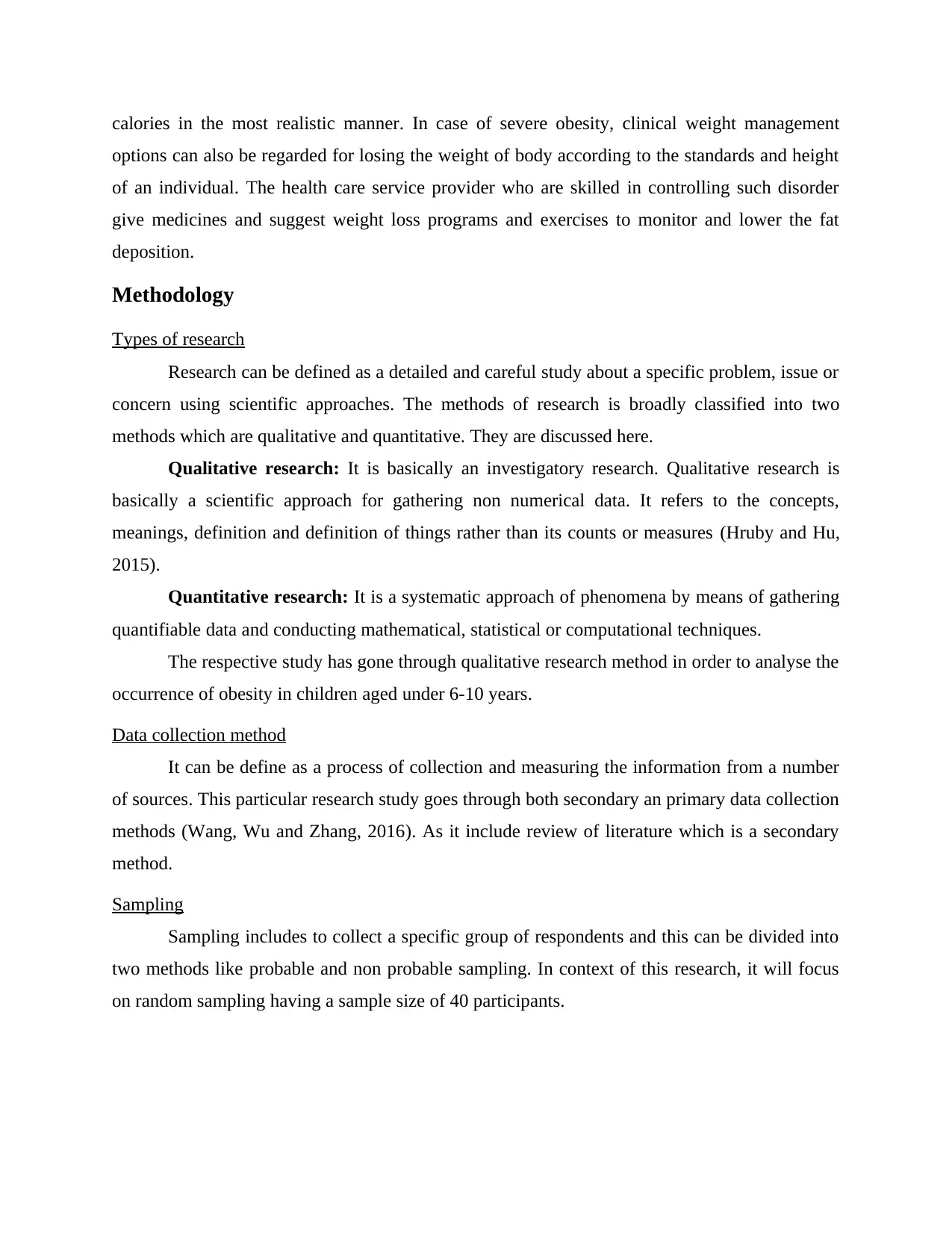
calories in the most realistic manner. In case of severe obesity, clinical weight management
options can also be regarded for losing the weight of body according to the standards and height
of an individual. The health care service provider who are skilled in controlling such disorder
give medicines and suggest weight loss programs and exercises to monitor and lower the fat
deposition.
Methodology
Types of research
Research can be defined as a detailed and careful study about a specific problem, issue or
concern using scientific approaches. The methods of research is broadly classified into two
methods which are qualitative and quantitative. They are discussed here.
Qualitative research: It is basically an investigatory research. Qualitative research is
basically a scientific approach for gathering non numerical data. It refers to the concepts,
meanings, definition and definition of things rather than its counts or measures (Hruby and Hu,
2015).
Quantitative research: It is a systematic approach of phenomena by means of gathering
quantifiable data and conducting mathematical, statistical or computational techniques.
The respective study has gone through qualitative research method in order to analyse the
occurrence of obesity in children aged under 6-10 years.
Data collection method
It can be define as a process of collection and measuring the information from a number
of sources. This particular research study goes through both secondary an primary data collection
methods (Wang, Wu and Zhang, 2016). As it include review of literature which is a secondary
method.
Sampling
Sampling includes to collect a specific group of respondents and this can be divided into
two methods like probable and non probable sampling. In context of this research, it will focus
on random sampling having a sample size of 40 participants.
options can also be regarded for losing the weight of body according to the standards and height
of an individual. The health care service provider who are skilled in controlling such disorder
give medicines and suggest weight loss programs and exercises to monitor and lower the fat
deposition.
Methodology
Types of research
Research can be defined as a detailed and careful study about a specific problem, issue or
concern using scientific approaches. The methods of research is broadly classified into two
methods which are qualitative and quantitative. They are discussed here.
Qualitative research: It is basically an investigatory research. Qualitative research is
basically a scientific approach for gathering non numerical data. It refers to the concepts,
meanings, definition and definition of things rather than its counts or measures (Hruby and Hu,
2015).
Quantitative research: It is a systematic approach of phenomena by means of gathering
quantifiable data and conducting mathematical, statistical or computational techniques.
The respective study has gone through qualitative research method in order to analyse the
occurrence of obesity in children aged under 6-10 years.
Data collection method
It can be define as a process of collection and measuring the information from a number
of sources. This particular research study goes through both secondary an primary data collection
methods (Wang, Wu and Zhang, 2016). As it include review of literature which is a secondary
method.
Sampling
Sampling includes to collect a specific group of respondents and this can be divided into
two methods like probable and non probable sampling. In context of this research, it will focus
on random sampling having a sample size of 40 participants.
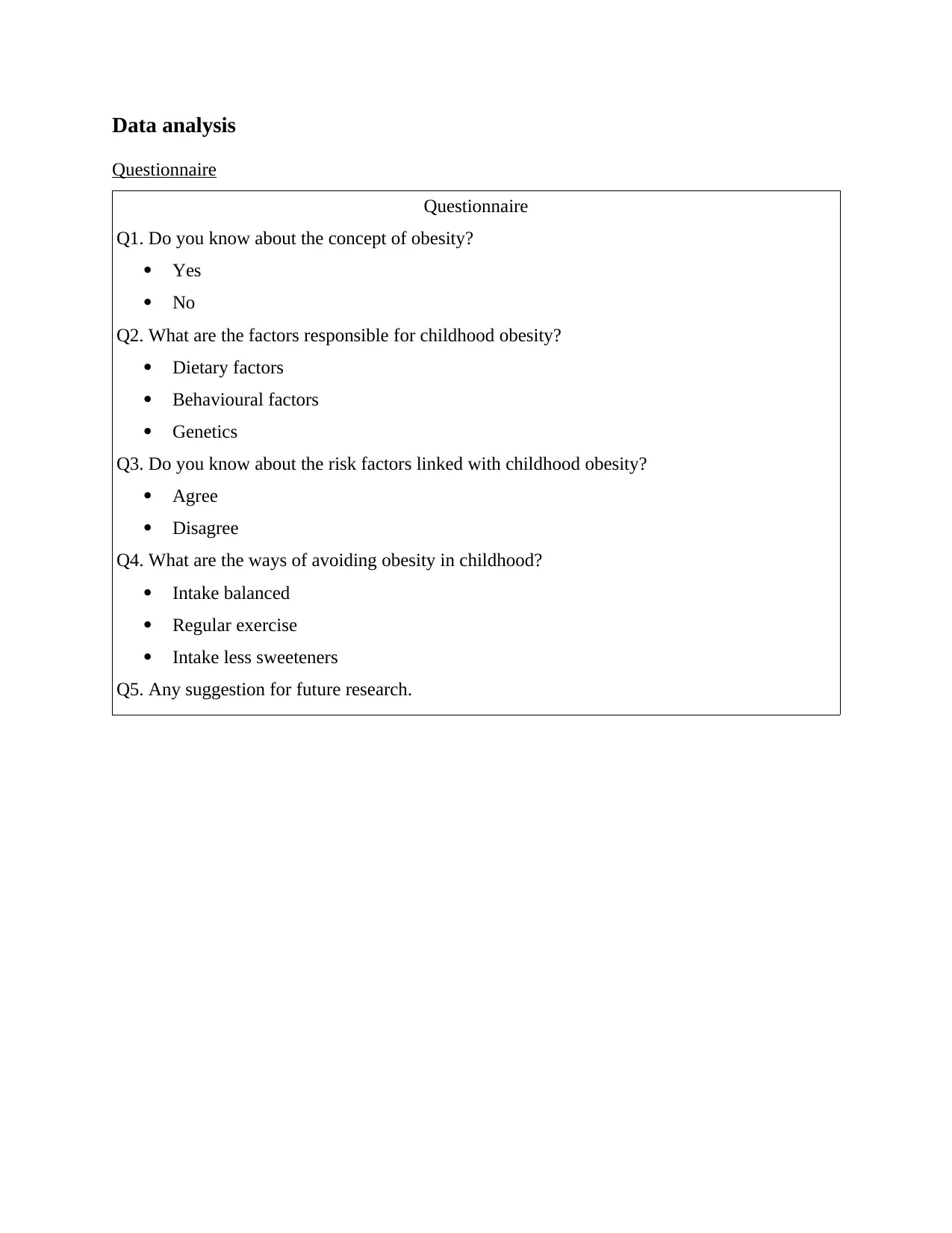
Data analysis
Questionnaire
Questionnaire
Q1. Do you know about the concept of obesity?
Yes
No
Q2. What are the factors responsible for childhood obesity?
Dietary factors
Behavioural factors
Genetics
Q3. Do you know about the risk factors linked with childhood obesity?
Agree
Disagree
Q4. What are the ways of avoiding obesity in childhood?
Intake balanced
Regular exercise
Intake less sweeteners
Q5. Any suggestion for future research.
Questionnaire
Questionnaire
Q1. Do you know about the concept of obesity?
Yes
No
Q2. What are the factors responsible for childhood obesity?
Dietary factors
Behavioural factors
Genetics
Q3. Do you know about the risk factors linked with childhood obesity?
Agree
Disagree
Q4. What are the ways of avoiding obesity in childhood?
Intake balanced
Regular exercise
Intake less sweeteners
Q5. Any suggestion for future research.
⊘ This is a preview!⊘
Do you want full access?
Subscribe today to unlock all pages.

Trusted by 1+ million students worldwide
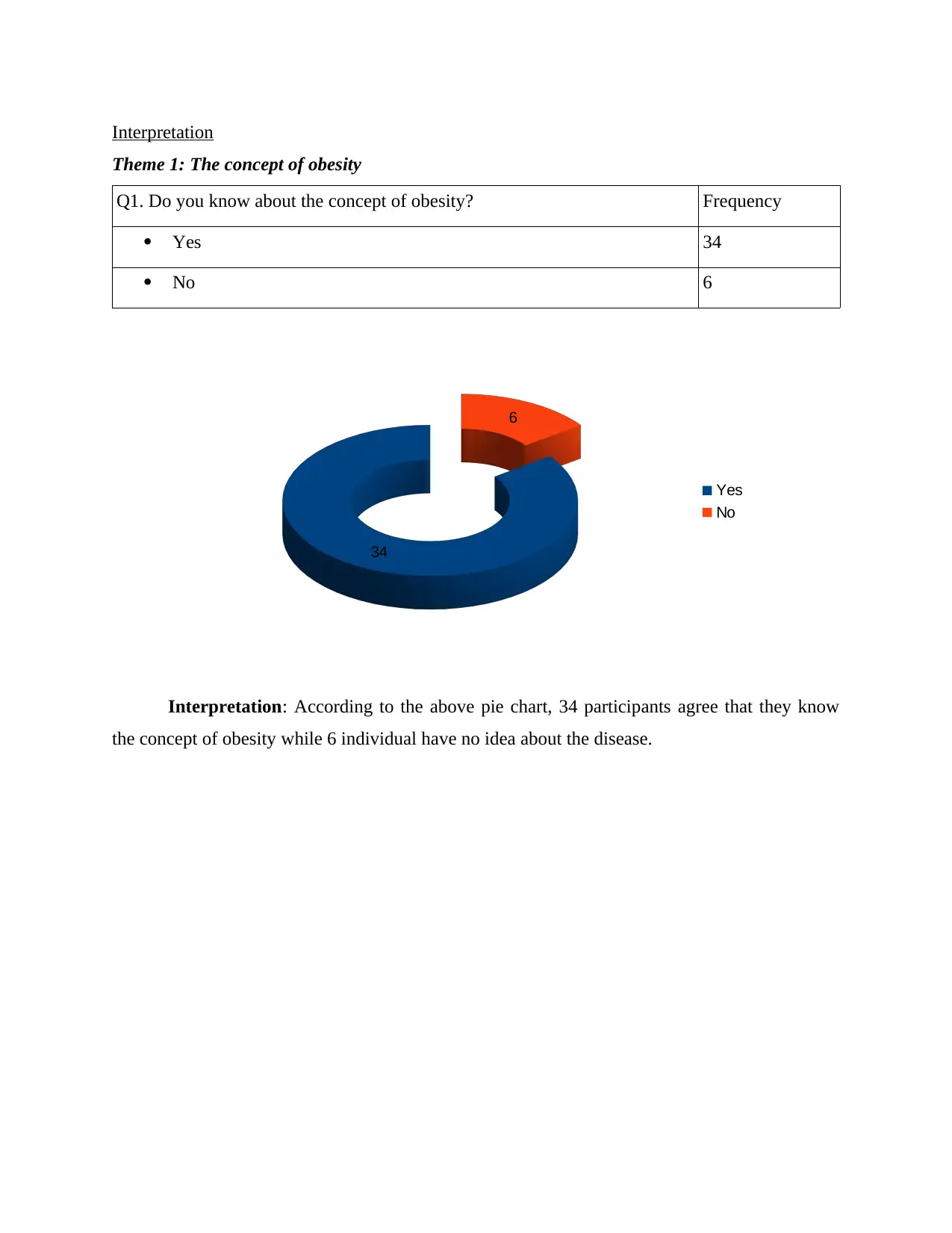
Interpretation
Theme 1: The concept of obesity
Q1. Do you know about the concept of obesity? Frequency
Yes 34
No 6
Interpretation: According to the above pie chart, 34 participants agree that they know
the concept of obesity while 6 individual have no idea about the disease.
34
6
Yes
No
Theme 1: The concept of obesity
Q1. Do you know about the concept of obesity? Frequency
Yes 34
No 6
Interpretation: According to the above pie chart, 34 participants agree that they know
the concept of obesity while 6 individual have no idea about the disease.
34
6
Yes
No
Paraphrase This Document
Need a fresh take? Get an instant paraphrase of this document with our AI Paraphraser

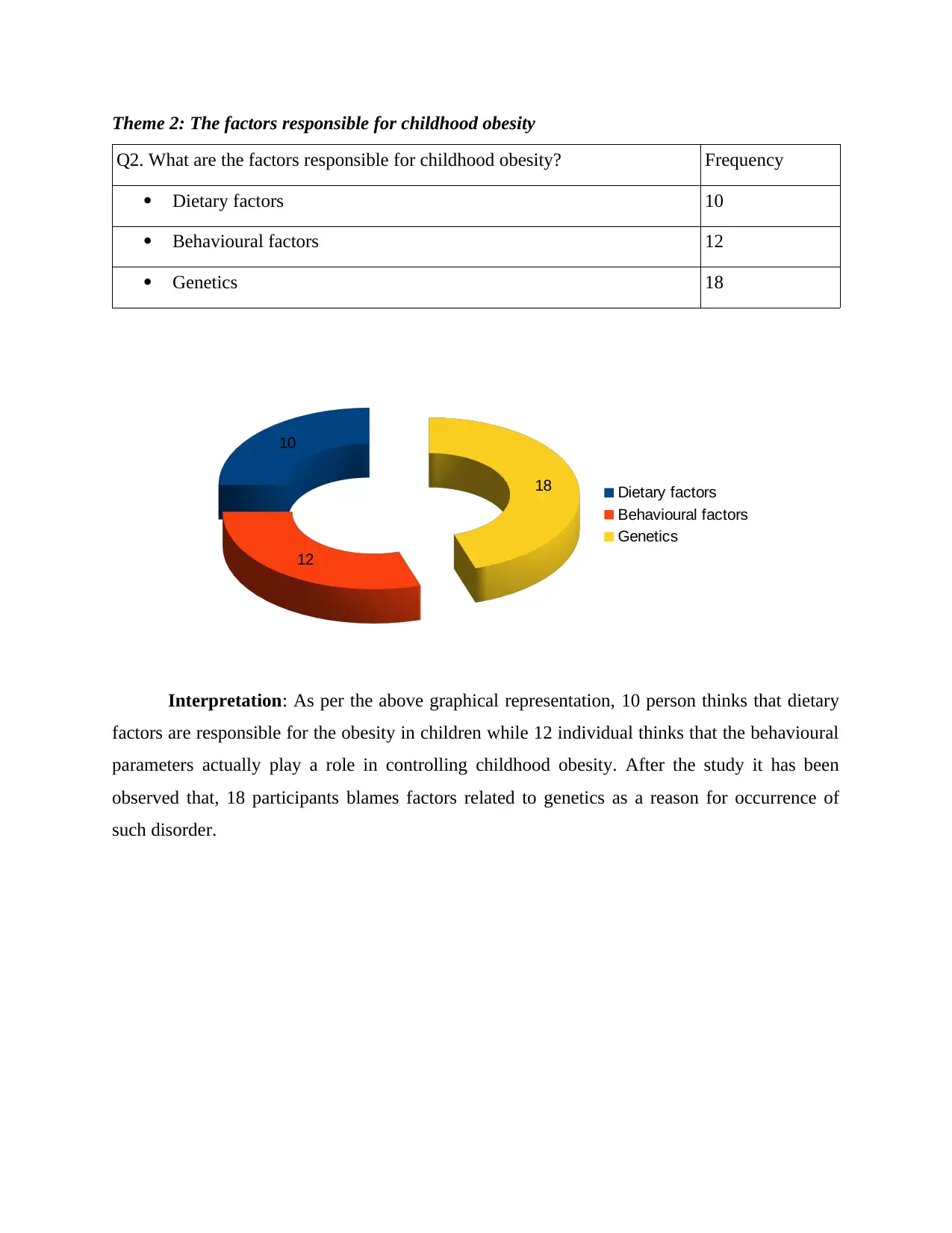
Theme 2: The factors responsible for childhood obesity
Q2. What are the factors responsible for childhood obesity? Frequency
Dietary factors 10
Behavioural factors 12
Genetics 18
Interpretation: As per the above graphical representation, 10 person thinks that dietary
factors are responsible for the obesity in children while 12 individual thinks that the behavioural
parameters actually play a role in controlling childhood obesity. After the study it has been
observed that, 18 participants blames factors related to genetics as a reason for occurrence of
such disorder.
10
12
18 Dietary factors
Behavioural factors
Genetics
Q2. What are the factors responsible for childhood obesity? Frequency
Dietary factors 10
Behavioural factors 12
Genetics 18
Interpretation: As per the above graphical representation, 10 person thinks that dietary
factors are responsible for the obesity in children while 12 individual thinks that the behavioural
parameters actually play a role in controlling childhood obesity. After the study it has been
observed that, 18 participants blames factors related to genetics as a reason for occurrence of
such disorder.
10
12
18 Dietary factors
Behavioural factors
Genetics
⊘ This is a preview!⊘
Do you want full access?
Subscribe today to unlock all pages.

Trusted by 1+ million students worldwide
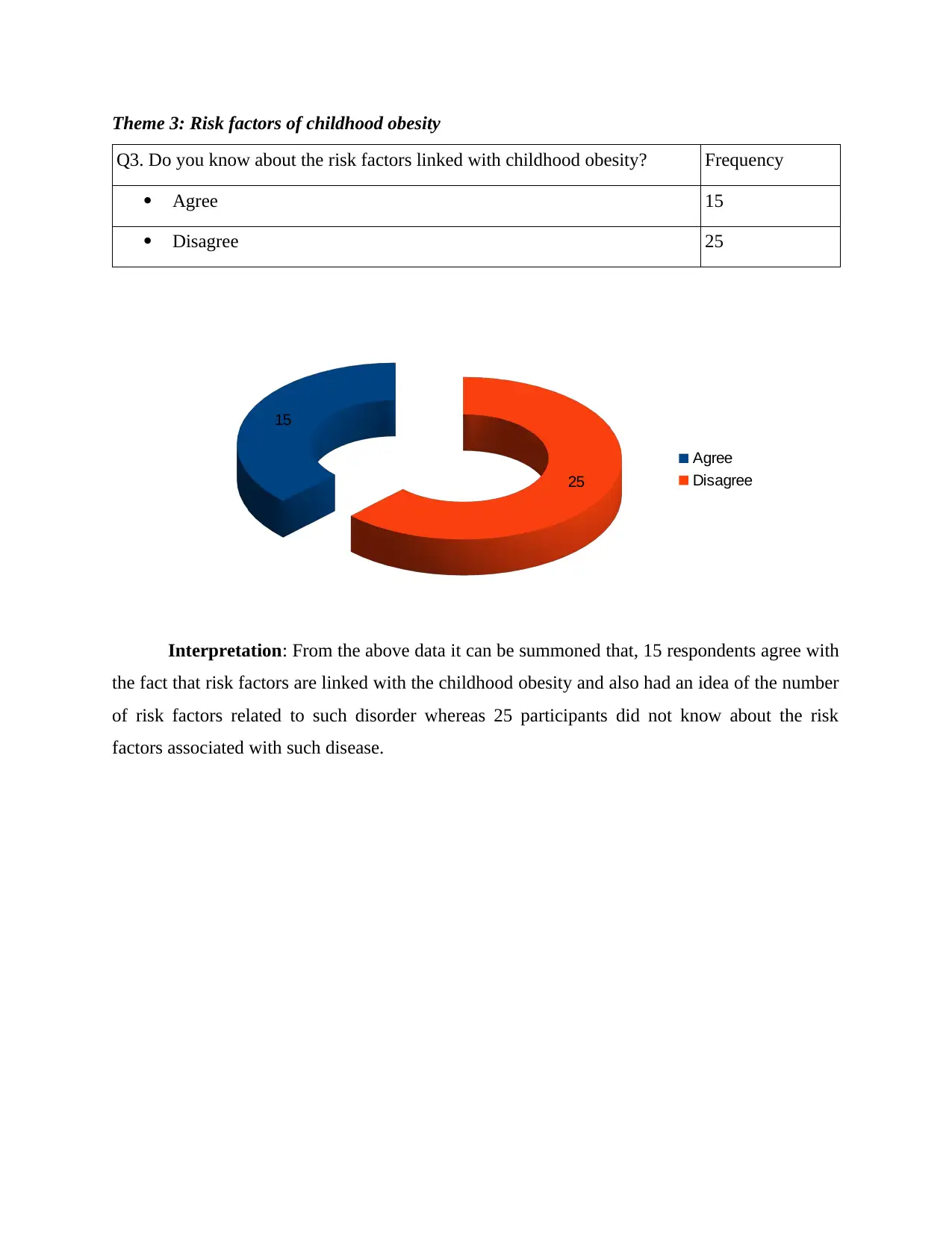
Theme 3: Risk factors of childhood obesity
Q3. Do you know about the risk factors linked with childhood obesity? Frequency
Agree 15
Disagree 25
Interpretation: From the above data it can be summoned that, 15 respondents agree with
the fact that risk factors are linked with the childhood obesity and also had an idea of the number
of risk factors related to such disorder whereas 25 participants did not know about the risk
factors associated with such disease.
15
25
Agree
Disagree
Q3. Do you know about the risk factors linked with childhood obesity? Frequency
Agree 15
Disagree 25
Interpretation: From the above data it can be summoned that, 15 respondents agree with
the fact that risk factors are linked with the childhood obesity and also had an idea of the number
of risk factors related to such disorder whereas 25 participants did not know about the risk
factors associated with such disease.
15
25
Agree
Disagree
Paraphrase This Document
Need a fresh take? Get an instant paraphrase of this document with our AI Paraphraser

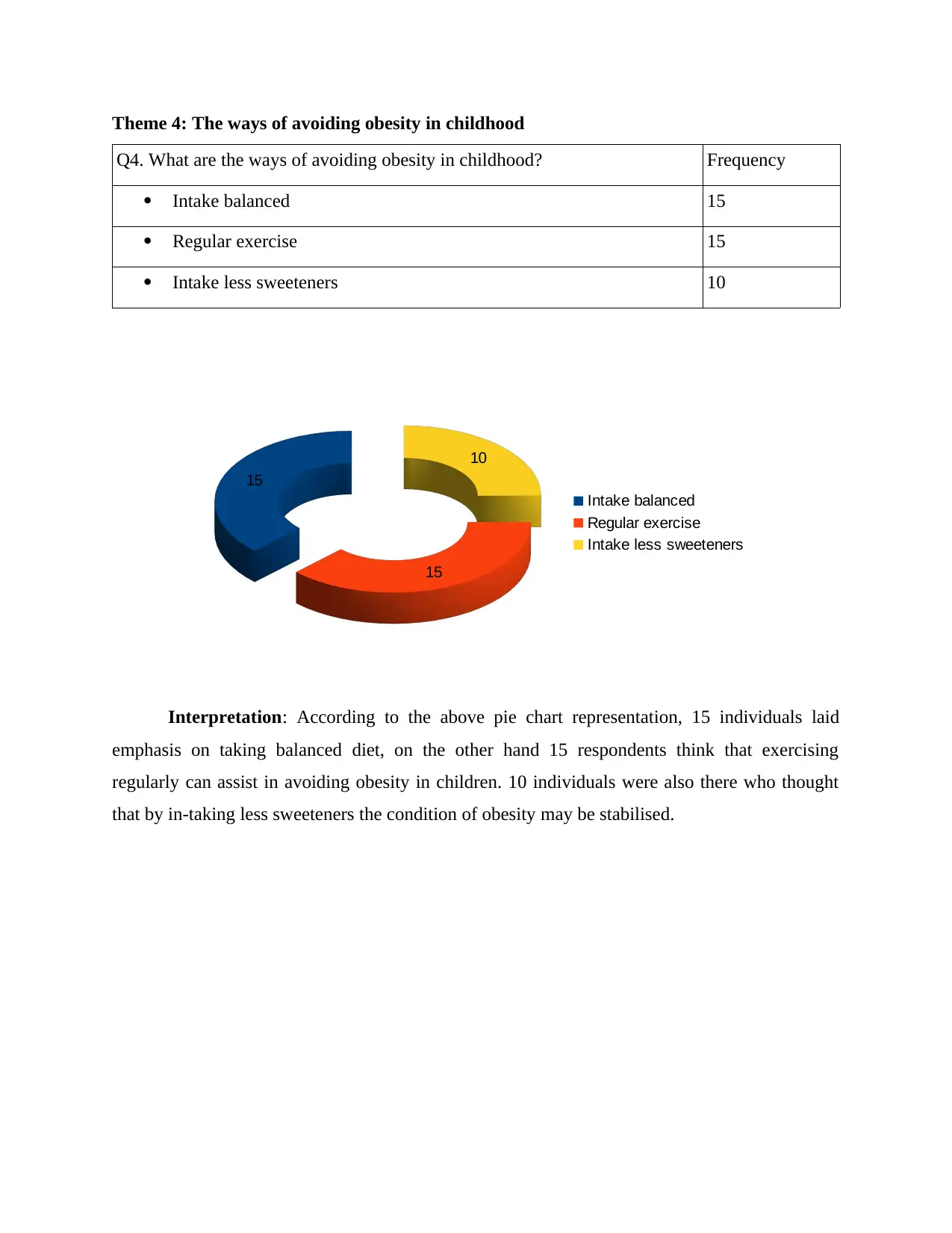
Theme 4: The ways of avoiding obesity in childhood
Q4. What are the ways of avoiding obesity in childhood? Frequency
Intake balanced 15
Regular exercise 15
Intake less sweeteners 10
Interpretation: According to the above pie chart representation, 15 individuals laid
emphasis on taking balanced diet, on the other hand 15 respondents think that exercising
regularly can assist in avoiding obesity in children. 10 individuals were also there who thought
that by in-taking less sweeteners the condition of obesity may be stabilised.
15
15
10
Intake balanced
Regular exercise
Intake less sweeteners
Q4. What are the ways of avoiding obesity in childhood? Frequency
Intake balanced 15
Regular exercise 15
Intake less sweeteners 10
Interpretation: According to the above pie chart representation, 15 individuals laid
emphasis on taking balanced diet, on the other hand 15 respondents think that exercising
regularly can assist in avoiding obesity in children. 10 individuals were also there who thought
that by in-taking less sweeteners the condition of obesity may be stabilised.
15
15
10
Intake balanced
Regular exercise
Intake less sweeteners
⊘ This is a preview!⊘
Do you want full access?
Subscribe today to unlock all pages.

Trusted by 1+ million students worldwide
1 out of 15
Related Documents
Your All-in-One AI-Powered Toolkit for Academic Success.
+13062052269
info@desklib.com
Available 24*7 on WhatsApp / Email
![[object Object]](/_next/static/media/star-bottom.7253800d.svg)
Unlock your academic potential
Copyright © 2020–2025 A2Z Services. All Rights Reserved. Developed and managed by ZUCOL.



